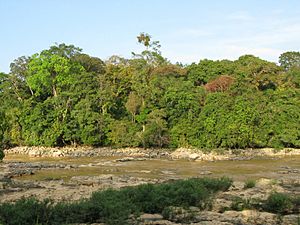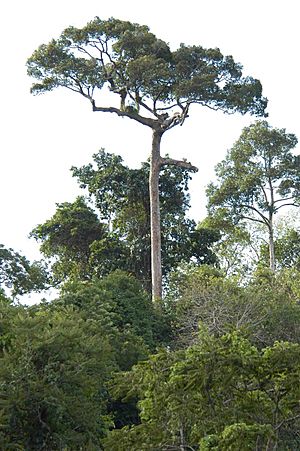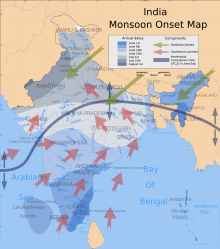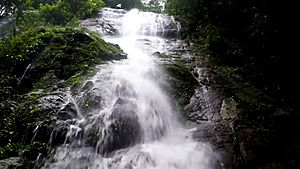Seasonal tropical forest facts for kids
Seasonal tropical forests are special places where some trees drop their leaves during the dry season, but others stay green all year. You might also hear them called moist deciduous, semi-evergreen seasonal, tropical mixed, or monsoon forests. These forests get a lot of rain, usually between 1000 and 2500 millimeters (39–98 inches) each year. Most of this rain falls during the warm summer wet season, followed by a cooler dry season. This kind of weather is often found in areas with a tropical monsoon climate or a Tropical savanna climate. Drier forests in these areas, where most trees lose their leaves, are called Tropical and subtropical dry broadleaf forests.
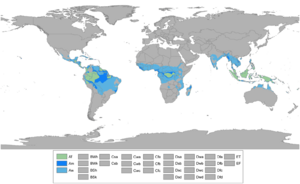
Contents
Where These Forests Are Found
You can find seasonal tropical forests in many parts of the world's tropical zone. Here are some examples:
- In the Americas
- The Atlantic forests in Brazil.
- Central and eastern Panama, especially Barro Colorado Island, which has been studied a lot.
- In Africa
- Along the coast of West Africa, known as the Guinean seasonal forest. This stretches from southwestern Gambia to eastern Ghana.
- The Madagascar lowland forests.
- In the Asia-Pacific Region
- These forests are common across large areas of the Indian subcontinent and Indochina.
- The Brahmaputra Valley semi-evergreen forests in India.
- Mondulkiri Province in Cambodia.
- Cat Tien National Park in Vietnam.
- Khao Yai National Park and Huai Kha Khaeng Wildlife Sanctuary in Thailand.
- Northern Australia, especially in Queensland.
Climate and Weather
The weather in seasonal forests is mostly controlled by a special weather zone near the equator called the ITCZ (Intertropical Convergence Zone). This zone is created where winds from the Northern and Southern Hemispheres meet. The ITCZ moves north in the northern summer and south in the northern winter. This movement is what brings the wet and dry seasons to tropical areas.
These forest regions have been getting warmer, about 0.26 degrees Celsius hotter each decade. This warming is happening because of human activities that release greenhouse gases into the air. Studies have also shown that some areas, like tropical Asia, are getting less rain and having more intense dry seasons. However, the Amazon region hasn't shown a clear change in rain patterns or dry season intensity.
Events like El Niño-Southern Oscillation (ENSO) also cause big changes in temperature and rainfall from year to year. They can lead to droughts and make the dry season much worse. As human-caused warming continues, ENSO events are expected to become stronger and happen more often. This could put a lot of stress on trees and other plants in these forests, making them more likely to die.
Forest Structure
Just like tropical rainforests, seasonal forests have different layers of trees, from the ground up to the very top. However, these layers might not be as clear in mixed forests. These forests often have many lianas, which are woody vines. Lianas grow very well here, especially during the dry season.
The word jungle is often used to describe these types of forests, especially in the Indian subcontinent. It doesn't have a specific scientific meaning, but it usually refers to a thick, wild forest. It can be hard to tell if a forest is 'old growth' (meaning it has never been cut down) or 'secondary' (meaning it has grown back after being cut). This is because things like soil and climate, as well as human activities, can change what the forest looks like.
Amazing Plants and Animals
The plants and animals in seasonal tropical mixed forests are often very unique. Many national parks are great places to see the amazing variety of life (called biodiversity) in these habitats.
- Africa has examples like:
- The northern part of Korup National Park in Cameroon.
-
- The Upper Guinean forests in West Africa.
- Asia has places like:
- Cat Tien National Park in Vietnam.
- Huai Kha Khaeng in Thailand (part of the Indochina region).
- Pacific Region includes:
- The Queensland forest reserves in Australia.
- Central America has rich wildlife in:
- Costa Rica, for example, Corcovado National Park.
- The Soberanía National Park in Panama.
- South America has many interesting plants listed and found in places like Rio Doce State Park in Brazil.
Images for kids


